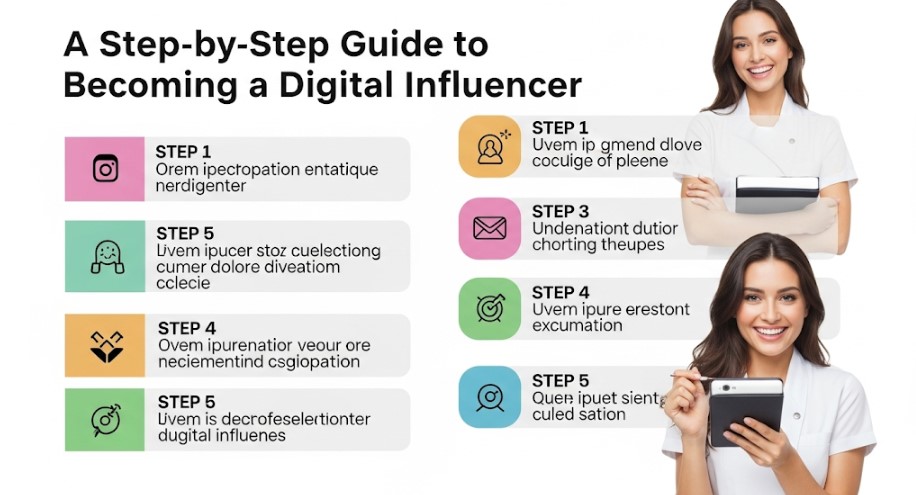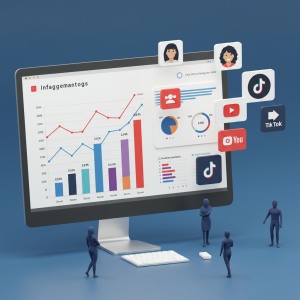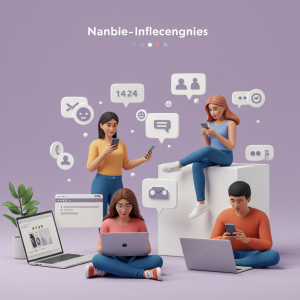What Are Digital Influencers (and How to Become One)

Digital influencers are shaping how we discover new products, form opinions, and engage with content online. From fashion and beauty to tech and finance, these content creators have built communities of loyal followers who trust their recommendations. This has completely changed the landscape of modern marketing.
But what exactly is a digital influencer? How do they build such dedicated followings, and what does it take to become one yourself? This guide will break down the world of digital influencers, exploring who they are, the impact they have, and the steps you can take to build your own online presence. You’ll gain a clear understanding of this powerful industry and learn how to navigate it, whether you’re a brand looking to collaborate or an aspiring creator.
What is a Digital Influencer?

A digital influencer is someone who has built a dedicated community around a specific niche or area of expertise online. They create and share content on platforms like Instagram, TikTok, YouTube, and personal blogs. Because of their authority and authenticity, they have the power to affect the purchasing decisions and opinions of their audience.
Unlike traditional celebrities who gain fame through movies or music, digital influencers build their reputation from the ground up by consistently producing valuable and engaging content. Their influence comes from the trust and rapport they establish with their followers, making their recommendations feel more like advice from a friend than a paid advertisement.
The Growing Impact of Influencer Marketing
The rise of digital influencers has given birth to influencer marketing, an industry now valued in the billions. Brands are increasingly allocating their marketing budgets to collaborate with influencers because it allows them to connect with target audiences in a more genuine and effective way.
Here’s why influencer marketing has become so powerful:
- Authentic Connections: Influencers offer a level of authenticity that traditional advertising often lacks. Their followers value their genuine opinions and personal stories.
- Targeted Reach: By partnering with an influencer in a specific niche, brands can directly reach a pre-existing community of engaged and relevant consumers.
- High Engagement: Influencer content often generates higher engagement rates (likes, comments, shares) than brand-owned content, leading to greater visibility and brand awareness.
- Measurable ROI: Modern analytics tools allow brands to track the performance of influencer campaigns, from website clicks and lead generation to direct sales, proving a clear return on investment.
Different Types of Digital Influencers
The term “influencer” covers a wide range of creators, often categorised by their follower count. Each tier offers unique advantages for brands and requires different strategies for collaboration.
Nano-Influencers (1,000–10,000 Followers)
Nano-influencers are everyday people with a smaller but highly engaged following. Their audience often consists of friends, family, and people with a strong shared interest in their niche. Because of their close-knit community, they boast the highest engagement rates and are seen as incredibly trustworthy. Brands often partner with them for hyper-local campaigns or to tap into very specific communities.
Micro-Influencers (10,000–100,000 Followers)
Micro-influencers have established themselves as experts in specific fields, such as sustainable fashion, vegan cooking, or personal finance. They have a larger reach than nano-influencers but still maintain a strong connection with their audience. They are a popular choice for brands because they offer a great balance of reach and engagement without the high price tag of larger influencers.
Macro-Influencers (100,000–1 Million Followers)
Macro-influencers are often professional content creators, bloggers, and vloggers who have turned their online presence into a full-time career. They have a broad reach and can generate significant brand awareness with a single post. While their engagement rates may be slightly lower than smaller influencers, their ability to reach a massive audience makes them valuable partners for large-scale campaigns.
Mega-Influencers (1 Million+ Followers)
Mega-influencers are the celebrities of the digital world. This category includes top-tier YouTubers, A-list social media stars, and traditional celebrities who have a strong online presence. Collaborating with a mega-influencer can provide massive exposure, but it comes at a significant cost. These partnerships are typically reserved for major brands with large marketing budgets.
A Step-by-Step Guide to Becoming a Digital Influencer

Building a career as a digital influencer requires dedication, strategy, and a genuine passion for your chosen niche. If you’re looking to build your own community and become a trusted voice online, here are the steps to get started.
1. Find Your Niche
The first and most important step is to choose a niche you are passionate and knowledgeable about. Your niche could be anything from vintage video games to urban gardening. A specific focus helps you attract a dedicated audience that shares your interests. Ask yourself:
- What topics do I genuinely love talking about?
- What unique skills or knowledge can I share?
- Is there an audience for this topic?
2. Choose Your Platforms
You don’t need to be on every social media platform. Instead, focus on one or two where your target audience is most active.
- Instagram: Ideal for visual niches like fashion, food, travel, and art.
- TikTok: Perfect for short-form video, trends, and entertainment.
- YouTube: The best platform for long-form video content, tutorials, and in-depth reviews.
- Blog: A great way to establish authority and share detailed written content.
3. Create High-Quality, Consistent Content
Your content is the foundation of your influence. Focus on creating posts, videos, or articles that are valuable, engaging, and high-quality. Consistency is also crucial. Develop a content calendar to plan your posts and ensure you are regularly providing fresh content to your audience. This keeps them engaged and signals to platform algorithms that your account is active.
4. Engage With Your Community
Building a loyal community is about more than just posting content. Take the time to interact with your followers.
- Respond to comments and direct messages.
- Ask questions in your captions to encourage discussion.
- Go live on Instagram or YouTube to chat with your audience in real time.
- Engage with other creators in your niche by commenting on their posts and collaborating.
5. Be Authentic and Transparent
Your followers value your authenticity. Be yourself and share your genuine opinions and experiences. If you partner with brands, be transparent about it. Disclose sponsored posts using hashtags like #ad or #sponsored. This honesty builds trust and strengthens your relationship with your audience.
Charting Your Path in the Digital Age
The world of digital influencers is more than just a passing trend; it represents a fundamental shift in how we communicate and connect. For brands, influencers offer an authentic bridge to engaged audiences. For aspiring creators, this path offers a chance to turn a passion into a profession by building a community around a shared interest.
Becoming a digital influencer requires a clear strategy, consistent effort, and a genuine desire to provide value. By identifying your niche, creating quality content, and fostering a strong community, you can build a meaningful online presence. Whether your goal is to share your expertise with a small group or reach millions, the principles of authenticity and engagement remain the key to success.





